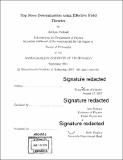| dc.contributor.advisor | lain Stewart. | en_US |
| dc.contributor.author | Pathak, Aditya, Ph. D. Massachusetts Institute of Technology | en_US |
| dc.contributor.other | Massachusetts Institute of Technology. Department of Physics. | en_US |
| dc.date.accessioned | 2018-04-27T18:10:36Z | |
| dc.date.available | 2018-04-27T18:10:36Z | |
| dc.date.copyright | 2017 | en_US |
| dc.date.issued | 2017 | en_US |
| dc.identifier.uri | http://hdl.handle.net/1721.1/115026 | |
| dc.description | Thesis: Ph. D., Massachusetts Institute of Technology, Department of Physics, 2017. | en_US |
| dc.description | Cataloged from PDF version of thesis. | en_US |
| dc.description | Includes bibliographical references (pages 231-239). | en_US |
| dc.description.abstract | The top quark mass is one of the most important Standard Model parameters and its mass has been measured at sub-percent precision by the Tevatron and LHC using Monte Carlo (MC) based methods. The resulting MC top mass parameter suffers from 0(1 GeV) uncertainty due to lack of specification of a precise field theoretic definition. Here a kinematic extraction method for obtaining a precisely defined short distance top mass at the LHC is proposed. A formula for factorized top jet mass cross section in the peak region is derived using methods of Effective Field Theory (EFT). It can then be used for direct comparison with data or for calibrating Monte Carlo simulations. Result for hard matching coefficient at two loops at the top mass scale is presented that enables N3LL logarithmic resumamtion of the cross section for top-jets in e+e- collisions. An effective theory setup for top mass extraction with soft drop grooming is derived, and is used to derive a factorization formula for the groomed jet mass distribution. Constraints from power counting in EFT limit the strength of groomers to "light grooming region". Studies with PYTHIA demonstrate that application of soft drop, even when restricted to light grooming, shows remarkable improvements in resilience to contamination from the underlying event (UE), has vastly reduced dependence the jet radius, and makes the top jet mass spectrum from pp collisions look like that of e+e- collisions as predicted. Modifications to the peaked spectrum from hadronization and UE for groomed top jets are suppressed and can be handled reliably. Using our factorization theorem results, a preliminary calibration study of Pythia top mass parameter is performed that yields results consistent with earlier calibrations for e+e- colliders. | en_US |
| dc.description.statementofresponsibility | by Aditya Pathak. | en_US |
| dc.format.extent | 239 pages | en_US |
| dc.language.iso | eng | en_US |
| dc.publisher | Massachusetts Institute of Technology | en_US |
| dc.rights | MIT theses are protected by copyright. They may be viewed, downloaded, or printed from this source but further reproduction or distribution in any format is prohibited without written permission. | en_US |
| dc.rights.uri | http://dspace.mit.edu/handle/1721.1/7582 | en_US |
| dc.subject | Physics. | en_US |
| dc.title | Top mass determination using Effective Field Theories | en_US |
| dc.title.alternative | Top mass determination using EFT | en_US |
| dc.type | Thesis | en_US |
| dc.description.degree | Ph. D. | en_US |
| dc.contributor.department | Massachusetts Institute of Technology. Department of Physics | |
| dc.identifier.oclc | 1031272930 | en_US |
